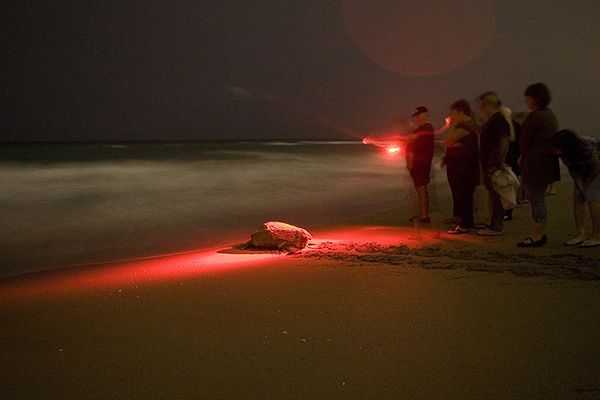
The darkness is the likes of which we rarely see in this illuminated 21st century. The wind is still, the rhythmic lapping of waves so small that they barely wet the beach. The cool damp sand is unlike the searing surface that burns our feet at noon. This is the night side of a summer day on a Florida beach. Noise and frolicking are replaced by quiet reverence as giant remnants of our prehistoric past laboriously make their way towards the dunes to deposit their eggs. Welcome to a nighttime sea turtle walk.
Nature Centers and parks up and down the Atlantic coast have been offering the walks for roughly the last two decades in the months of June and July. Ask anyone who has participated and they wholeheartedly agree that it is the most awe inspiring natural history experience you can have on the beach while still keeping your feet dry. The walks are part of a permitted program administered by the Florida Fish and Wildlife Conservation Commission. Permit holders go through training so that all precautions are taken to protect the females of five different species of sea turtles that have been using our coast for thousands of millennium to perpetuate their species, even though only loggerheads can be viewed. The loggerhead is the only sea turtle species considered one step better off by being designated a threatened species, only in danger of becoming endangered. The other four species in Florida waters – Kemp’s ridley, hawksbill, leatherback and green sea turtles – are listed as endangered species.
Facts about the importance of Florida beaches for sea turtles will knock your socks off. On the east coast of the U.S. sea turtle nesting extends from the Florida Keys to Virginia and from Texas to Florida on the Gulf Coast, but only five counties on the east coast of Florida from Cape Canaveral through Palm Beach during May through August host over 15,000 female loggerheads, each averaging five nests. Eighty percent of all sea turtles that nest in the continental United States do so on Florida beaches, currently making close to 100,000 nests. It is not hard to imagine Florida as the sea turtle nesting capital of North America.
The question that we are often asked at our Coastal Center is why are sea turtles important? Think of it like this, one of man’s biggest impacts to aquatic environments is our constant input of nutrients into the water from terrestrial sources. Sea turtles are one of the few animal groups that by coming ashore to breed actually move nutrients from the sea to the land. We lament the natural loss of turtle hatchlings and yet the huge numbers that unsuccessfully make it to adulthood by legitimate processes are important contributors to numerous food webs.
An early letter from an east coast resident described egg collecting which was part of life here in the early 20th century – now very illegal – but the most shocking revelation was that his biggest competitor on the beach for eggs was black bears. Nowadays their natural land-based predators include snakes, ants, birds, mammals and crabs, and there are countless species that take advantage of the plenitude offshore. One of our local fishers describes snappers literally lined up at the splash zone along the beach when hatchlings are entering the water. Remnant shells and eggs that do not hatch for whatever reason become part of dune enrichment that keeps that ecosystem healthy and enables the following years’ breeding classes to reap the benefits. Although sad from a turtle-lover’s perspective, whenever a natural process enables the perpetuation of other species it is a dramatic example of a food web in nature.
That is not to say that every loss is natural, it is estimated that most adult deaths other than from their natural predators, sharks, are due to the ingestion of oil globules, a number that is difficult to quantify since the deaths occur offshore where the carcasses are never found. Additional man-made threats include plastic debris, commercial fishing practices that attract and then drown these airbreathing reptiles, removal of nesting beaches, harvesting which still occurs throughout the world, and boat collisions. These are some of the factors that undoubtedly have led to the listing of six of the seven sea turtle species worldwide as endangered by tipping the balance between surviving and going extinct.
The guided nighttime sea turtle walks are one of a growing number of changes we have made to protect these magnificent reptiles. Accompanied by qualified scouts people are allowed to approach and marvel at a large threatened species on its own turf without putting it in jeopardy which has fostered the commitment of individuals and communities to preserve them and their dwindling habitat. It is a fantastic opportunity that without a doubt should be on your bucket list.
Ellie Van Os is Director of Education and Exhibits for the Florida Oceanographic Society. She can be contacted at evanos@floridaocean.org and by phone at (772) 225-0505 ext. 113
[easy-social-share]